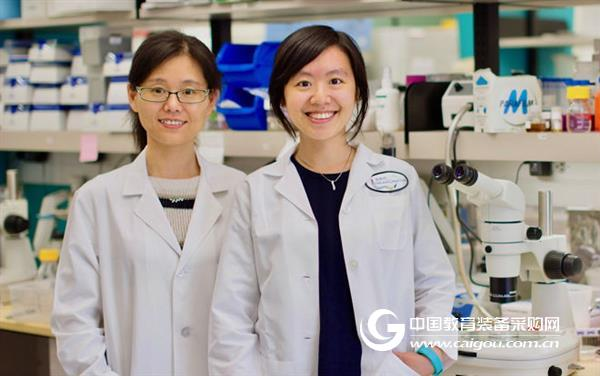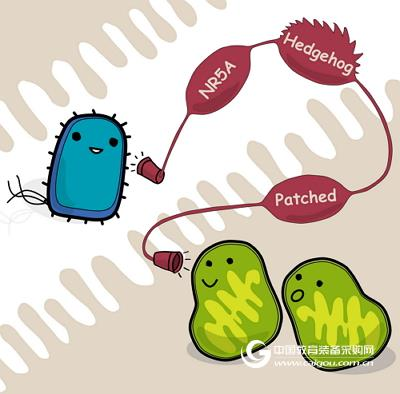Guide
An article published online in the journal Nature Cell Biology reveals an interesting phenomenon: bacteria cultured under nutrient-deficient conditions can affect their host's gain! More importantly, the research team first focused on "environment-bacteria-host" Factors that explain the molecular mechanisms behind this phenomenon. Bio-Exploration was fortunate to interview the author of the article, Wang Meng, a lifelong professor at Baylor College of Medicine, and his student, and Dr. Lin Zhijun, who asked them to share this latest study for us.

Microorganisms are widespread in our own environment and in the environment in which they live, no matter the type or quantity, they are far beyond our imagination. More importantly, they are closely related to our health. But how do microbes affect the health of the host? How do you perceive the external environment? This is why scientists have been "infatuated" by these tiny living things.
On April 24th, the journal Nature Cell Biology published an article entitled "Microbial metabolites regulate host lipid metabolism through NR5A-Hedgehog signalling", which firstly analyzed the interaction between environment and bacteria on the host from a new perspective. The effects of fat metabolism.
They found that when nutrients are scarce, the physiological metabolism of the bacteria itself is affected, which further leads to the growth of the host nematode! This means that the changes in the bacteria due to the environment will directly affect the host, which will obviously affect the fat metabolism. Impact.
Why does the host become fatter? Does it have any indication of human diet? In this regard, Bio-Exploration has the honor to interview the author of the article, Wang Meng, a lifelong professor at Baylor College of Medicine, and his student, and Dr. Lin Zhijun.
1
The latest research: bacteria lack nutrients, causing the host to gain weight?!
In order to understand how the environment (nutrition) affects host health by changing bacterial metabolism, Professor Wang Meng led the team to select wild type E. coli and its host C. elegans as research materials. They cultured the bacteria in two different nutrient environments (nutrition-rich LB medium, nutrient-poor M9 medium). Subsequently, bacteria cultured in both environments were provided to their host C. elegans.
“The results are very interesting.†Professor Wang Meng said, “We found that although the energy intake of nematodes did not change, the nematodes that lived with the bacteria that were lacking in nutrient growth became fatter! Their body fat content has more than doubled! â€
Why do you gain weight?
The first step: the impact of the environment (nutrition deficiency) on bacteria
According to the whole metabolome analysis, the team found that nutrient deprivation leads to significant changes in bacterial biochemical metabolism, especially sugar metabolism and amino acid metabolism. However, not all changes have an effect on host fat metabolism, but when nutrition is scarce, the bacteria lack methionine to cause obesity.
Specifically, the lack of methionine affects the single carbon metabolism cycle of bacteria, resulting in betaine, homocycteine, methionine, dimethylglycine. lack of.
Step 2: Bacteria further affect host fat metabolism
Deletion of bacterial metabolites can result in the inability of host nematodes to efficiently synthesize phosphatidylcholine. Under normal circumstances, choline phosphate is a very important signaling molecule responsible for the activation of the nuclear hormone receptor NHR-25. Activated NHR-25 further regulates the downstream hedgehog signaling pathway and controls fat storage by affecting mitochondrial activity.
Therefore, when the specific choline phosphate is insufficient, NHR-25 can not be activated, further linking the downstream Hedgehog signaling pathway, resulting in the shape and function of the host mitochondria being affected, and finally causing a large accumulation of fat.

In the absence of nutrients, bacterial metabolism changes, resulting in a lack of methionine, which in turn affects the host's inability to efficiently synthesize specific choline phosphates. For the host, the lack of choline phosphate affects the NHR-25/Hedgehog signaling pathway, which affects the morphology and function of the mitochondria and ultimately leads to fat accumulation.
2
Mitochondria: a bridge between bacterial and host information exchange
Professor Wang Meng's team found that after the bacterial metabolites entered the nematode, a series of biochemical reactions and NHR-25/Hedgehog signaling pathways affected the morphology of mitochondria. As an important place for fat metabolism, there is a high correlation between mitochondrial morphology and fat content:
When the mitochondria become elongated strips, the fat content decreases; when the mitochondria becomes a point of breakage, the fat content increases.
Mitochondria still retain many bacterial properties, such as own genomes, bilayer membranes, and some similar biochemical metabolic reactions. According to Dr. Lin, “Based on this latest study, we boldly assume that the chemical signals of mitochondria in bacteria and eukaryotic cells may have highly conserved regulatory mechanisms. Cells can sense the 'dark' of bacteria through mitochondria, thereby making a response to the external environment. Timely and rapid physiological response."
This latest study reveals that mitochondria can act as an important bridge between bacteria and host eukaryotic cells, helping them to communicate metabolic information. This will bring about a subversive change in the concept of mitochondrial function.
3
How do bacteria “eat� Depends on the environment
For humans, we need to add a variety of foods every day. While we enjoy these external nutrients, the bacteria living in the intestines are also sensing changes in the environment, thereby adjusting their gene expression and metabolic reactions, so as to quickly adapt to the new environment and survive better. Changes in bacterial metabolic reactions produce different metabolites that in turn affect humans.
Dr. Lin said that under nutrient-rich conditions, bacteria are like going to “restaurantsâ€. They can directly absorb high-molecular-weight organic substances such as amino acids, sugars and lipids in the environment through “orderingâ€. On the contrary, when nutrition is scarce, bacteria can only “cook themselves in the kitchenâ€, synthesizing organic macromolecules from inorganic small molecules step by step to meet their own needs for survival and reproduction.
4
Bacterial “early perception†environment compared to the host
In the interview, Professor Wang Meng told the bio-exploration: “The metabolic changes caused by bacteria in response to nutrient deprivation will cause the host to accumulate fat. If the host does not eat anything, the accumulation of fat caused by bacteria will increase its chances of survival.†In a nutrient-poor environment, although the host is not hungry, the bacteria have predicted environmental changes in advance, and began to accumulate fat when food is sufficient, and prepare in advance. This "predictive adaptive response" is beneficial to the survival of the host, including humans.
"In the period of the War of Resistance, the baby born to the mother during famine and malnutrition, if the nutritional conditions became adequate, he/she is more likely to develop obesity, blood sugar intolerance or type 2 diabetes and other metabolic diseases than others." Dr. Lin Explain, "So, when the future environmental changes predicted by the adaptive response are the same, the advance preparation of the bacteria is beneficial to the host; however, if the prediction and the reality deviate, it will become a negative effect. â€
All in all, the perception of the environment by bacteria will be transformed into metabolic signals, which will help the host to cope with environmental stress and make it more adaptable.
5
Because they are symbiotic with us, the prospects and significance are extraordinary.
Microorganisms are ubiquitous, and microbial populations that live on the surface or in the lumen can help the host build an immune system that works together against foreign pathogenic microorganisms. In addition to affecting immunity, intestinal microbes have been shown to affect metabolism, efficacy, mood, and more. Microorganisms are involved in the decomposition of foods and drugs, affecting the absorption efficiency of the host, and their metabolites may indirectly affect the nerve cells. Once imbalanced, it may lead to depression, anxiety, loss of appetite and other consequences.
It is precisely because of such inseparable dependencies that more and more scientists are “hearted†about microbes. As one of them, Professor Wang Meng is more focused on the “symbiotic relationshipâ€. She believes that the symbiotic microbiota is very important for the body, and describes the future trends and directions of microbiology research from the following three aspects:
First, analyze the differences in individual microbes and help precision medicine. Studies have shown that the same gene therapy may have very different effects because of the commensal microbes. In many cases, the difference in microbes between individuals is much greater than the difference in genomes.
Second, to benefit and avoid harm, screening beneficial symbiotic microorganisms. There are many types and types of microbial populations. How can we screen out the types that are beneficial to us? How to avoid harmful groups? The answers to these questions can provide clues for health care.
Third, look for new microbes and their metabolites to promote health. In the future, we can promote host health and even prevent disease by discovering new microbial population structures, specific species, and metabolites to regulate the dynamic balance of microbial populations.
“Whether it is medical, agricultural, health food, or even environmental protection, microbes have great application prospects,†Dr. Lin stressed.
6
Studying microbes, interesting because of the unknown
With the aid of a microscope, scientists can see a world completely different from what the naked eye sees, filled with unknowns and fun. “From proposing new problems, designing new experimental systems, and finally figuring out the signal transduction molecular pathways between multiple tissues, this is a study we have done very well. It is found that the communication mechanism between bacteria and mitochondria is beyond our expectation. Professor Wang Meng commented.
Dr. Lin believes that as long as the heart is bold, the microbes will be fun. She admits that microbes are sensitive and fragile, and experimenting requires careful and careful care.
At the end of the interview, talking about the opportunity to pay attention to microbes, Professor Wang Meng replied: “Microorganisms exist in our bodies. By studying these subtle living organisms, we can find ways to improve the basic health of normal people, which is for everyone. Meaningful. Looking at a deeper level, improving health is also an effective way to prevent and combat the occurrence and development of diseases."
Shanghai Chuangsai Technology has excellent performance, interleukin cytokines, fetal bovine serum, electrophoresis equipment scientific instruments, raw material drug standards, chemical reagents, cell culture consumables, Shanghai Chuangsai, mass products special promotions, welcome to inquire!
Eos Portable Baby Booster Seat
Zhejiang Lamon Technology Inc. , https://www.babychaires.com
